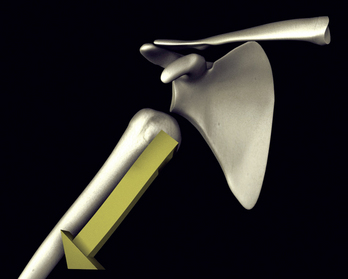Chapter 52 Shoulder Dislocation Reduction
Common indications
Shoulder dislocation is a common injury in sports or activities that involve high-velocity injuries such as skiing or contact sports. The most common injury is the anteroinferior dislocation (Figure 52-1). Reduction of this injury in the acute setting improves patient comfort and reduces the risk of neurovascular injury. The patient presents in acute pain, often holding the affected side in flexion and internal rotation. If appropriate monitoring is available, sedation can be useful to provide better muscular relaxation and patient comfort. However, the longer that the dislocation is in place, the greater the spasm that develops. Reduction can be accomplished without sedation in many cases.
Techniques
There are several methods to reduce the dislocation. The general principle is to apply traction and rotate the humerus externally with a slight extension of the humerus to dislodge it from the inferior aspect of the glenoid fossa (Figure 52-2). In patients with poor muscular development, a simple external rotation or extension may be enough to relocate the shoulder. Scapular rotation, rotating the glenoid fossa downward toward the dislocated humeral head, may also work in similar patients (Figure 52-3).
Stay updated, free articles. Join our Telegram channel

Full access? Get Clinical Tree




